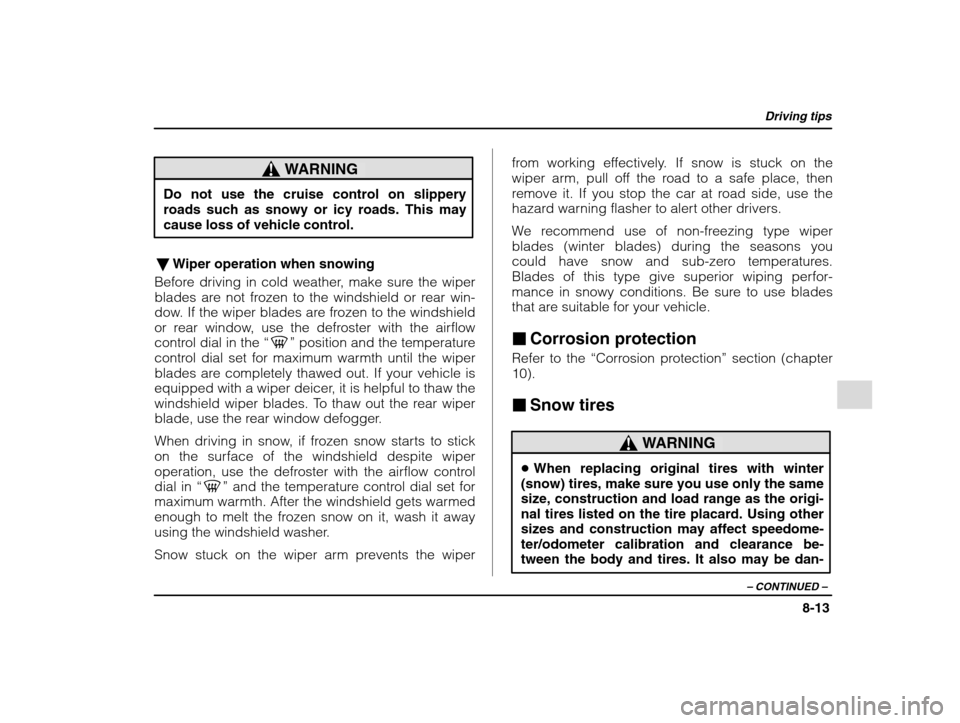2002 SUBARU IMPREZA air condition
[x] Cancel search: air conditionPage 207 of 390

Starting and operating
7-6
State emission testing (U.S. only) At state inspection time, remember to tell your inspection or service station in advance not to
place your Subaru AWD vehicle on a two-wheel
dynamometer. Otherwise, serious transmission
damage will result.
Some states have started using dynamometers in
their state inspection programs in order to meet their
obligation under federal law to implement stricter
vehicle emission standards to reduce air pollution
from cars. A dynamometer is a treadmill or roller-like testing device that allows your car ’s wheels to turn
while the car remains in one place. Depending onthe severity of a state ’s air pollution problems, the
states must adopt either a “basic” or “enhanced”
vehicle emission inspection test. Normally, a portion of the basic emission test consists of an emission
inspector inserting an analyzer probe into the
exhaust pipe of an idling vehicle for a short period
of time. States with more severe air pollution prob-
lems are required to adopt an enhanced vehicleemission test. This test simulates actual driving
conditions on a dynamometer and permits more
accurate measurement of tailpipe emitted pollution
than the basic emission test. The U.S. Environmental Protection Agency (EPA)and states using two-wheel dynamometers in their
emission testing programs have
EXEMPTED
Subaru AWD vehicles from the portion of the testing
program that involves a two-wheel dynamometer.
There are some states that use four-wheel
dynamometers in their testing programs. When
properly used, that equipment will not damage an
AWD Subaru vehicle.
Under no circumstances should the rear wheels be
jacked off the ground, nor should the driveshaft be
disconnected for state emission testing.
WARNING
Testing of an All-Wheel Drive vehicle must
NEVER be performed on a single two-wheel
dynamometer. Attempting to do so will resultin uncontrolled vehicle movement and may
cause an accident or injuries to persons
nearby.
Page 233 of 390

Driving tips
8-2
New vehicle break-in driving –
the first 1,000 miles (1,600 km)
The performance and long life of your vehicle are
dependent on how you handle and care for your ve-
hicle while it is new. Follow these instructions duringthe first 1,000 miles (1,600 km):� Do not race the engine. And do not allow engine
speed to exceed 4,000 rpm except in an emergen-
cy. � Do not drive at one constant engine or vehicle
speed for a long time, either fast or slow. � Avoid starting suddenly and rapid acceleration,
except in an emergency.� Avoid hard braking, except in an emergency.
The same break-in procedures should be applied to
an overhauled engine, newly mounted engine or
when brake pads or brake linings are replaced withnew ones. Fuel economy hints The following suggestions will help to save your fuel. �
Select the proper gear position for the speed and
road conditions. � Avoid sudden acceleration or deceleration. Al-
ways accelerate gently until you reach the desired
speed. Then try to maintain that speed for as longas possible.� Do not pump the accelerator and avoid racing the
engine. � Avoid unnecessary engine idling.
� Keep the engine properly tuned.
� Keep the tires inflated to the correct pressure
shown on the tire placard, which is located under the door latch on the driver ’s side. Low pressure will
increase tire wear and fuel consumption. � Use the air conditioner only when necessary.
� Keep the front and rear wheels in proper align-
ment. � Avoid carrying unnecessary luggage or cargo.
Page 236 of 390

Driving tips
8-5
– CONTINUED –
running rough (misfiring, backfiring or incomplete
combustion), have your vehicle checked and re-
paired by an authorized SUBARU dealer.�Do not apply undercoating or rust prevention
treatment to the heat shield of catalytic converterand the exhaust system.
WARNING
� Avoid fire hazards. Do not drive or park the
vehicle anywhere near flammable materials
(e.g. grass, paper, rags or leaves), because the catalytic converter operates at very hightemperatures.� Keep everyone and flammable materials
away from the exhaust pipe while the engineis running. The exhaust gas is very hot. Periodic inspections
To keep your vehicle in the best condition at all
times, always have the recommended maintenance
services listed in the maintenance schedule in the“
Warranty and Maintenance Booklet ” performed at
the specified time or mileage intervals.
Page 239 of 390

Driving tips
8-8
Off road driving
WARNING
�Always maintain a safe driving speed ac-
cording to the road and weather conditions in order to avoid having an accident on a sharpturn, during sudden braking or under othersimilar conditions.� Always use the utmost care in driving –
overconfidence because you are driving an allwheel drive vehicle could easily lead to a seri-ous accident.
� All AWD models except OUTBACK SPORT
Your AWD vehicle is neither a conventional off-road
vehicle nor an all terrain vehicle. It is a passenger
car designed primarily for on-road use. The AWD
feature gives it some limited off-road capabilities in
situation in which driving surfaces a relatively level,
obstruction-free and otherwise similar to on-road driving conditions. Operating it under other than those conditions could subject the vehicle to exces-
sive stress which might result in damage not eligible for repair under warranty. If you do take your
SUBARU off road, you should review the common
sense precautions in the next section (applicable to
the OUTBACK SPORT) for general guidance. Butplease keep in mind that your vehicle
’s off-road ca-
pabilities are more limited than those of the OUT-
BACK SPORT.
Never attempt to drive through pools and puddles,
or roads flooded with water. Water entering the
engine air intake or the exhaust pipe or water
splashing onto electrical parts may damage your
vehicle and may cause it to stall. � OUTBACK SPORT
Because of the AWD feature and higher ground
clearance, your Subaru can be driven on ordinary
roads or off-road. But please keep in mind that an
AWD SUBARU is a passenger car and is neither a
conventional off-road vehicle nor an all-terrain ve-
hicle. If you do take your Subaru off-road, certain
common sense precautions such as the following should be taken: � Make certain that you and all of your passengers
are wearing seat belts. � Carry some emergency equipment, such as a
towing rope or chain, a shovel, wheel blocks, first
Page 244 of 390

Driving tips
8-13
– CONTINUED –
WARNING
Do not use the cruise control on slippery roads such as snowy or icy roads. This may
cause loss of vehicle control.
� Wiper operation when snowing
Before driving in cold weather, make sure the wiper
blades are not frozen to the windshield or rear win-
dow. If the wiper blades are frozen to the windshield
or rear window, use the defroster with the airflow
control dial in the “t ” position and the temperature
control dial set for maximum warmth until the wiper
blades are completely thawed out. If your vehicle is
equipped with a wiper deicer, it is helpful to thaw the
windshield wiper blades. To thaw out the rear wiper
blade, use the rear window defogger.
When driving in snow, if frozen snow starts to stick
on the surface of the windshield despite wiper
operation, use the defroster with the airflow controldial in “t ” and the temperature control dial set for
maximum warmth. After the windshield gets warmed
enough to melt the frozen snow on it, wash it away
using the windshield washer.
Snow stuck on the wiper arm prevents the wiper from working effectively. If snow is stuck on the
wiper arm, pull off the road to a safe place, then
remove it. If you stop the car at road side, use the
hazard warning flasher to alert other drivers.
We recommend use of non-freezing type wiper blades (winter blades) during the seasons you
could have snow and sub-zero temperatures.
Blades of this type give superior wiping perfor-
mance in snowy conditions. Be sure to use blades
that are suitable for your vehicle.
� Corrosion protection
Refer to the “Corrosion protection ” section (chapter
10). � Snow tires
WARNING
�When replacing original tires with winter
(snow) tires, make sure you use only the same size, construction and load range as the origi-nal tires listed on the tire placard. Using other
sizes and construction may affect speedome-ter/odometer calibration and clearance be-tween the body and tires. It also may be dan-
Page 265 of 390

Driving tips
8-34
�Side mirrors
HB0085
After hitching a trailer to your vehicle, check that the
standard side mirrors provide a good rearward field of view without significant blind spots. If significant blind spots occur with the vehicle ’s standard side
mirrors, use towing mirrors that conform with Fed-
eral, state/province and/or other applicable regula-tions.
� Trailer lights
Connection of trailer lights to your vehicle ’s electrical
system requires modifications to the vehicle ’s light-
ing circuit to increase its capacity and accommo-
date wiring changes. To ensure the trailer lights are
connected properly, please consult your SUBARU dealer. Check for proper operation of the turn sig-nals, the brake lights and parking lights each timeyou hitch up.
CAUTION
Direct splicing or other improper connection
of trailer lights may damage your vehicle
’s
electrical system and cause a malfunction of your vehicle ’s lighting system.
� Tires
Make sure that all the tires on your vehicle are prop-
erly inflated to the pressure specified on the tire
placard located on the left center pillar of your ve-hicle.
Trailer tire condition, size, load rating and proper
inflation pressure should be in accordance with the
trailer manufacturer ’s specifications.
In the event your vehicle gets a flat tire when towing
a trailer, ask a commercial road service to repair the
flat tire.
If you carry a regular size spare tire in your vehicle
or trailer as a precaution against getting a flat tire,
be sure that the spare tire is firmly secured.
Page 267 of 390

Driving tips
8-36
�Driving with a trailer
� You should allow for considerably more stopping
distance when towing a trailer. Avoid sudden brak-
ing because it may result in skidding or jackknifing
and loss of control.� Avoid abrupt starts and sudden accelerations. If
your vehicle has a manual transmission, always start
out in first gear and release the clutch at moderate
engine revolution.� Avoid uneven steering, sharp turns and rapid lane
changes.� Slow down before turning. Make a longer than
normal turning radius because the trailer wheels will
be closer than the vehicle wheels to the inside of the
turn. In a tight turn, the trailer could hit your vehicle.� Crosswinds will adversely affect the handling of
your vehicle and trailer, causing sway. Crosswindscan be due to weather conditions or the passing of
large trucks or buses. If swaying occurs, firmly grip the steering wheel and slow down immediately but
gradually.� When passing other vehicles, considerable dis-
tance is required because of the added weight and
length caused by attaching the trailer to yourvehicle. � Backing up with a trailer is difficult and takes
practice. When backing up with a trailer, never accelerate or steer rapidly. When turning back, grip the bottom of the steering wheel with one hand and
turn it to the left for a left turn, and turn it to the right
for a right turn.
OM-H2791
1) Left turn 2) Right turn
� If the ABS warning light illuminates while the
vehicle is in motion, stop towing the trailer and have
repairs performed immediately by the nearest
SUBARU dealer.
� Driving on grades
� Before going down a steep hill, slow down and
shift into lower gear (if necessary, use 1st gear) in
order to utilize the engine braking effect and prevent
overheating of your vehicle ’s brakes. Do not make
Page 268 of 390

Driving tips
8-37
– CONTINUED –
sudden downshifts. �When driving uphill in hot weather, the air condi-
tioner may turn off automatically to protect the
engine from overheating.� When driving uphill in hot weather, pay attention to
the water temperature gauge pointer (for all
vehicles) and AT OIL TEMP warning light (for AT
vehicles) since the engine and transmission are rel-
atively prone to overheating under these conditions.
If the water temperature gauge pointer approaches
the OVERHEAT zone or the AT OIL TEMP warning
light illuminates, immediately switch off the air condi-
tioner and stop the vehicle at the nearest safe place. Refer to the “Engine overheat ” section in chapter 9,
and “Warning and indicator lights ” section in chap-
ter 3.� If your vehicle has a automatic transmission, avoid
using the accelerator pedal to stay stationary on an
uphill slope instead of using the parking brake or
foot brake. That may cause the transmission fluid to
overheat. Also, if your vehicle is equipped with an
automatic transmission, avoid driving with the gearselector lever in “D” when towing a heavy trailer to
prevent fluid overheating.
� Parking on a grade
Always block the wheels under both vehicle and
trailer when parking. Apply the parking brake firmly. You should not park on a hill or slope. But if parkingon a hill or slope cannot be avoided, you shouldtake the following steps:
1. Apply the brakes and hold the pedal down.
2. Have someone place wheel blocks under boththe vehicle and trailer wheels.
3. When the wheel blocks are in place, release the
regular brakes slowly until the blocks absorb theload.
4. Apply the regular brakes and then apply the
parking brake; slowly release the regular brakes.
5. Shift into 1st or reverse gear (manual transmis- sion) or
“P” (automatic transmission) and shut off the
engine.